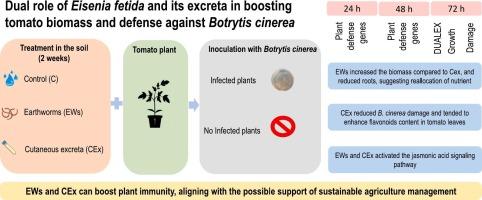Dual role of Eisenia fetida and its excreta in boosting tomato biomass and defense against Botrytis cinerea
IF 3.4
2区 农林科学
Q2 BIOTECHNOLOGY & APPLIED MICROBIOLOGY
引用次数: 0
Abstract
Soil organisms are key to plant growth and ecosystem functions. Earthworms (EWs) enhance soil and indirectly affect plant growth, while their cutaneous excreta (CEx) contain bioactive compounds capable of eliciting plant responses. However, their role in plant immunity is still not well understood. We hypothesized that EWs and their CEx enhance plant defense against foliar pathogens by activating induced resistance. To test this, we evaluated the effect of Eisenia fetida and their CEx on Solanum lycopersicum (tomato), focusing on growth, physiology, and defense response against Botrytis cinerea. Plants were exposed to EWs, CEx, or water (control), followed by B. cinerea infection after two weeks. Gene expression of defense markers was assessed at 24 and 48 h post-inoculation (hpi), while physiological parameters and disease severity were evaluated at 72 hpi. EWs increased shoot biomass compared to CEx, while both treatments reduced root dry weight, suggesting a possible shift in resource allocation. CEx significantly reduced B. cinerea-induced leaf damage and showed a trend for flavonoid accumulation, a known marker of induced resistance. Both treatments, EWs and CEx, activated the jasmonic acid (JA) signaling pathway, with CEx specifically upregulated genes involved in fungal pathogen defense, sustaining their expression over time. The present study offers, for the first time, clear evidence that earthworm-derived CEx can induce resistance by stimulating plant defense responses. Further biochemical, transcriptomic, and metabolomic analyses are needed to confirm indirect results, along with field validation. Nonetheless, the findings underscore the crucial role of soil biodiversity in enhancing crop resilience.

肥Eisenia fetida及其排泄物在提高番茄生物量和防御灰霉病中的双重作用
土壤生物是植物生长和生态系统功能的关键。蚯蚓(EWs)改善土壤并间接影响植物生长,而它们的皮肤排泄物(CEx)含有能够引起植物反应的生物活性化合物。然而,它们在植物免疫中的作用仍未得到很好的理解。我们假设EWs及其CEx通过激活诱导抗性来增强植物对叶面病原体的防御。为了验证这一点,我们评估了爱森ia fetida及其CEx对番茄(Solanum lycopersicum)的影响,重点研究了番茄的生长、生理和对番茄灰霉菌(Botrytis cinerea)的防御反应。将植物暴露于EWs、CEx或水(对照)中,两周后再感染灰葡萄球菌。接种后24和48 h (hpi)评估防御标记的基因表达,72 hpi评估生理参数和疾病严重程度。与CEx相比,EWs处理增加了地上部生物量,而两种处理都降低了根干重,表明资源分配可能发生了变化。CEx显著降低了绿芽甘蓝诱导的叶片损伤,并表现出黄酮类化合物积累的趋势,这是已知的诱导抗性标志。EWs和CEx两种处理都激活了茉莉酸(JA)信号通路,其中CEx特异性上调了参与真菌病原体防御的基因,并随着时间的推移维持其表达。本研究首次提供了明确的证据,证明蚯蚓来源的CEx可以通过刺激植物的防御反应来诱导抗性。需要进一步的生化、转录组学和代谢组学分析来确认间接结果,并进行现场验证。尽管如此,这些发现强调了土壤生物多样性在提高作物抗灾能力方面的关键作用。
本文章由计算机程序翻译,如有差异,请以英文原文为准。
求助全文
约1分钟内获得全文
求助全文
来源期刊

Biological Control
生物-昆虫学
CiteScore
7.40
自引率
7.10%
发文量
220
审稿时长
63 days
期刊介绍:
Biological control is an environmentally sound and effective means of reducing or mitigating pests and pest effects through the use of natural enemies. The aim of Biological Control is to promote this science and technology through publication of original research articles and reviews of research and theory. The journal devotes a section to reports on biotechnologies dealing with the elucidation and use of genes or gene products for the enhancement of biological control agents.
The journal encompasses biological control of viral, microbial, nematode, insect, mite, weed, and vertebrate pests in agriculture, aquatic, forest, natural resource, stored product, and urban environments. Biological control of arthropod pests of human and domestic animals is also included. Ecological, molecular, and biotechnological approaches to the understanding of biological control are welcome.
 求助内容:
求助内容: 应助结果提醒方式:
应助结果提醒方式:


